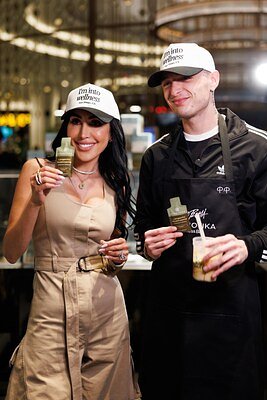
Beyond the Hype: How Luxury Resorts & Musicians Are Fueling the Wellness Boom
From high-end spas to celebrity endorsements, the wellness industry is undergoing a radical shift. We explore how brands like Cymbiotika & Fontainebleau are tapping into a new era of holistic health.
Beyond the Hype: How Luxury Resorts & Musicians Are Fueling the Wellness Boom
Las Vegas, NV – The intersection of wellness and entertainment is rapidly evolving, driven by a growing consumer desire for holistic health experiences. A recent collaboration between functional food brand Cymbiotika and luxury resort Fontainebleau Las Vegas exemplifies this trend, offering a glimpse into how brands are capitalizing on the burgeoning wellness market. But beyond the celebrity endorsements and Instagram-worthy smoothies, what's really driving this boom, and is it sustainable?
The Rise of Experiential Wellness
The wellness industry isn’t new, but its approach is changing. Consumers are increasingly seeking experiences – not just products – that promote physical and mental wellbeing. This shift is particularly pronounced in the luxury travel sector, where guests are demanding more than just opulent accommodations. Fontainebleau Las Vegas is betting big on this trend, investing heavily in a comprehensive wellness ecosystem.
“We’re seeing a significant increase in demand for integrated wellness experiences,” explains a hospitality industry analyst. “Guests want to combine relaxation, fitness, and healthy dining into their overall vacation. It’s no longer enough to simply offer a spa; resorts need to create a holistic environment that supports wellbeing.”
Fontainebleau’s strategy includes a 50,000-square-foot spa offering cutting-edge treatments like cryotherapy and IV therapy, a state-of-the-art gym, and healthy dining options. The addition of the Cymbiotika Wellness Bar, offering functional beverages and supplements, further solidifies the resort's commitment to holistic health.
Cymbiotika's Strategy: From Supplements to Social Influence
Cymbiotika, founded in 2019, has quickly become a prominent player in the functional food space. The company distinguishes itself through its use of liposomal technology, designed to enhance the bioavailability of nutrients. However, Cymbiotika's growth isn’t solely based on product innovation; it’s also heavily reliant on strategic marketing and influencer collaborations.
The partnership with Fontainebleau is a prime example of this strategy. By associating its brand with a luxury resort, Cymbiotika aims to reach a new audience and reinforce its image as a premium wellness provider. But the company’s reach extends far beyond the Vegas strip. Cymbiotika consistently partners with influential figures, leveraging their social media presence to promote its products and build brand awareness.
“Influencer marketing is crucial in the wellness space,” notes a marketing consultant. “Consumers are more likely to trust recommendations from people they admire and relate to. Cymbiotika is effectively tapping into this dynamic by collaborating with individuals who embody a healthy and active lifestyle.”
The company’s strategy appears to be working. Cymbiotika has experienced rapid growth in recent years, with revenue estimated at $30 million in 2023. Website traffic has surged, and the brand has garnered a significant following on social media.
Beyond the Buzz: Are These Trends Sustainable?
While the convergence of wellness and luxury is undoubtedly a compelling trend, questions remain about its long-term sustainability. Is this simply a fleeting fad, or a genuine shift in consumer behavior? And are the products and experiences being offered truly beneficial, or merely marketing hype?
One concern is the potential for “wellness washing” – the practice of companies exaggerating the health benefits of their products or services. With the wellness industry largely unregulated, consumers need to be discerning and skeptical of bold claims.
“It’s important to do your research and look beyond the marketing buzz,” advises a registered dietitian. “Not all wellness products are created equal. Look for brands that are transparent about their ingredients and backed by scientific evidence.”
Another challenge is accessibility. Luxury wellness experiences are often prohibitively expensive, making them inaccessible to the vast majority of consumers. This raises concerns about equity and inclusivity within the wellness industry.
“Wellness should be accessible to everyone, not just the affluent,” argues a public health advocate. “We need to find ways to democratize wellness and make healthy options more affordable and equitable.”
The smoothie offered at the Cymbiotika Wellness Bar, while containing beneficial ingredients like oats, coconut milk, and liposomal mushrooms, offers a good example of this. While nutritionally sound, the high sugar content from dates and honey could be a concern for some, and the price point is significantly higher than a homemade smoothie.
The Future of Wellness
The wellness industry is poised for continued growth in the years ahead. Consumers are becoming increasingly proactive about their health, and they’re demanding more from the brands they choose. The key to success will be authenticity, transparency, and a commitment to providing genuine value.
For luxury resorts like Fontainebleau, this means investing in comprehensive wellness ecosystems that cater to the holistic needs of their guests. For brands like Cymbiotika, it means prioritizing product innovation, transparency, and ethical marketing practices. And for consumers, it means being discerning, skeptical, and prioritizing their wellbeing over hype.
Ultimately, the future of wellness will depend on our ability to create a more equitable, sustainable, and accessible industry that benefits everyone.
